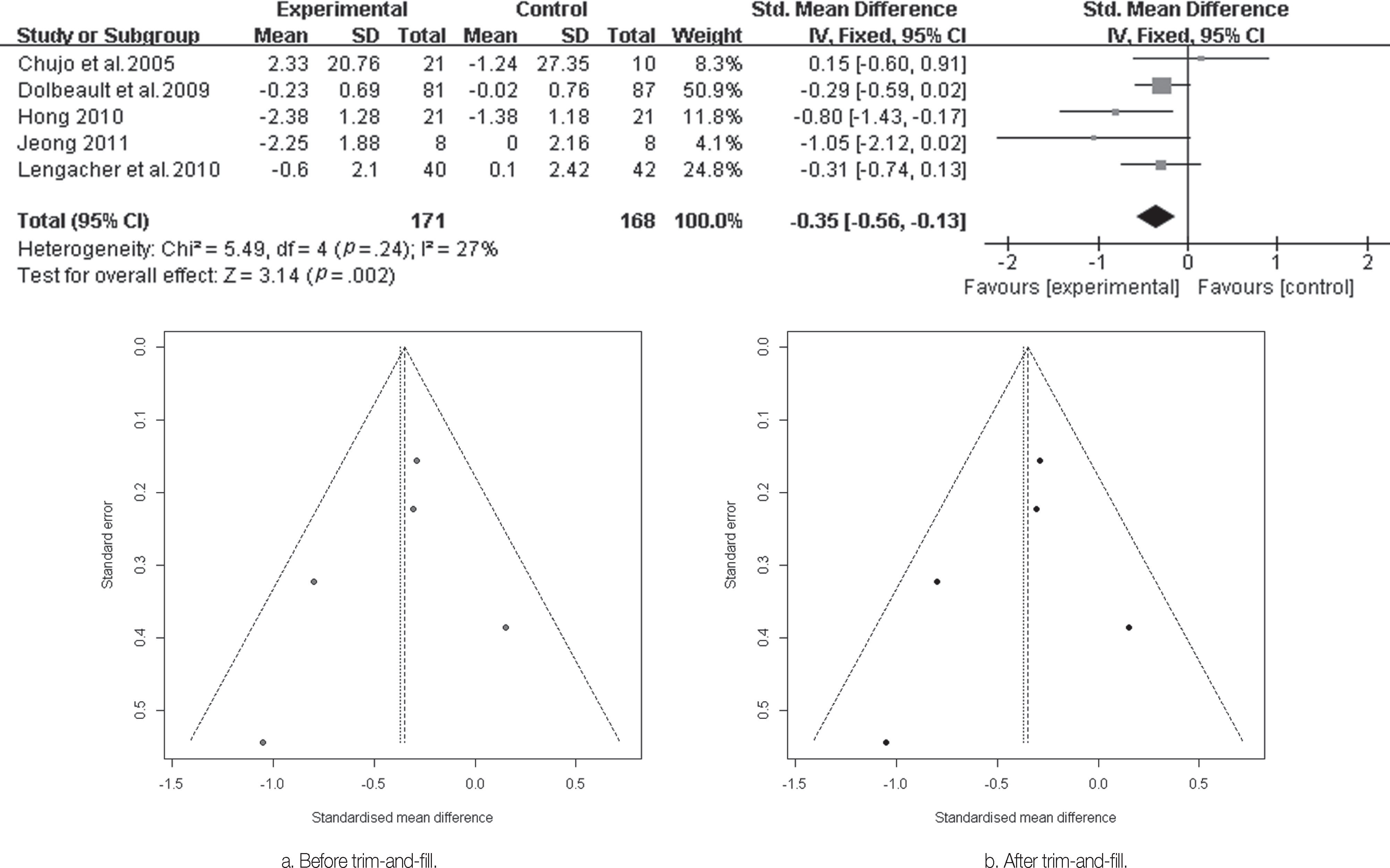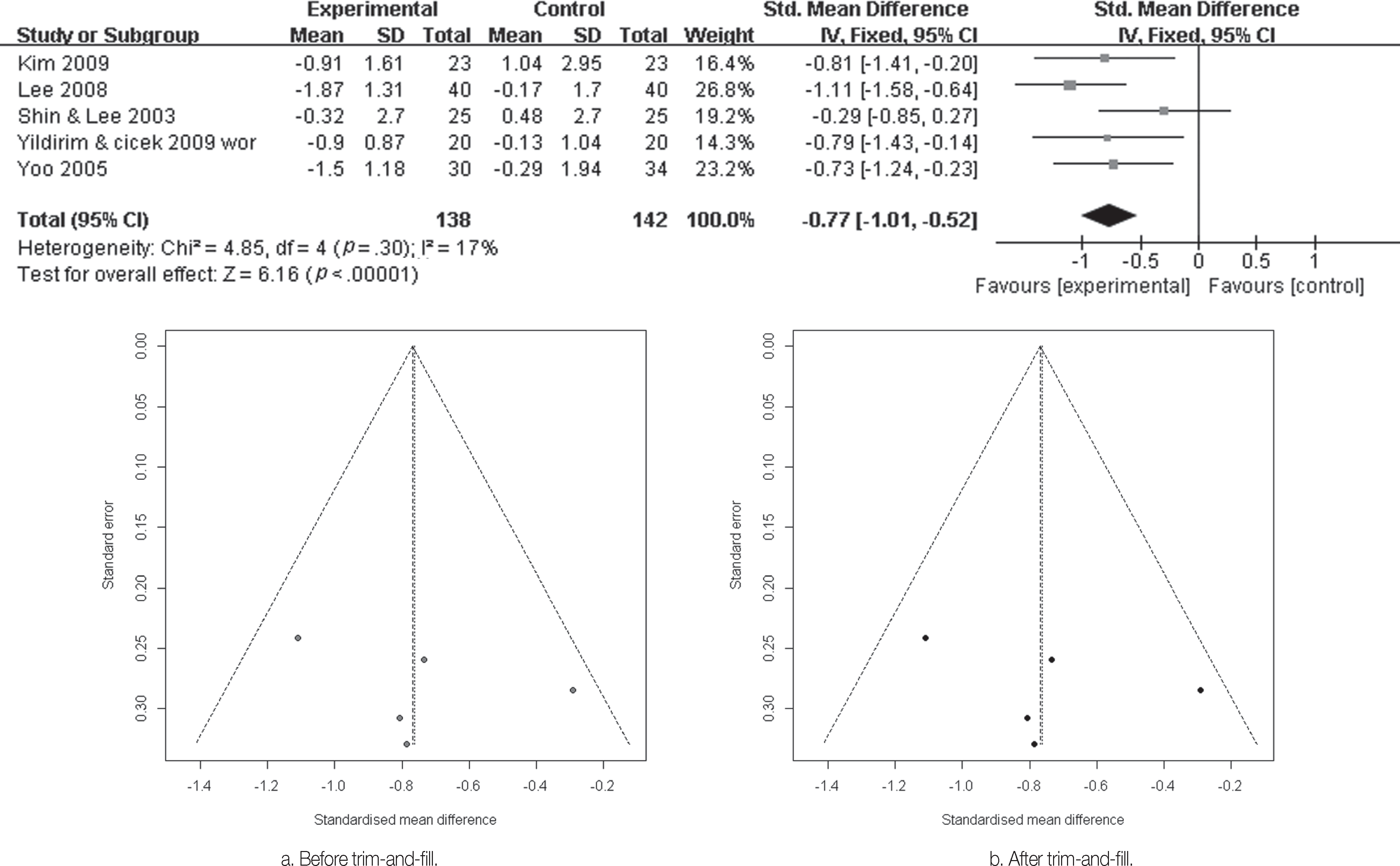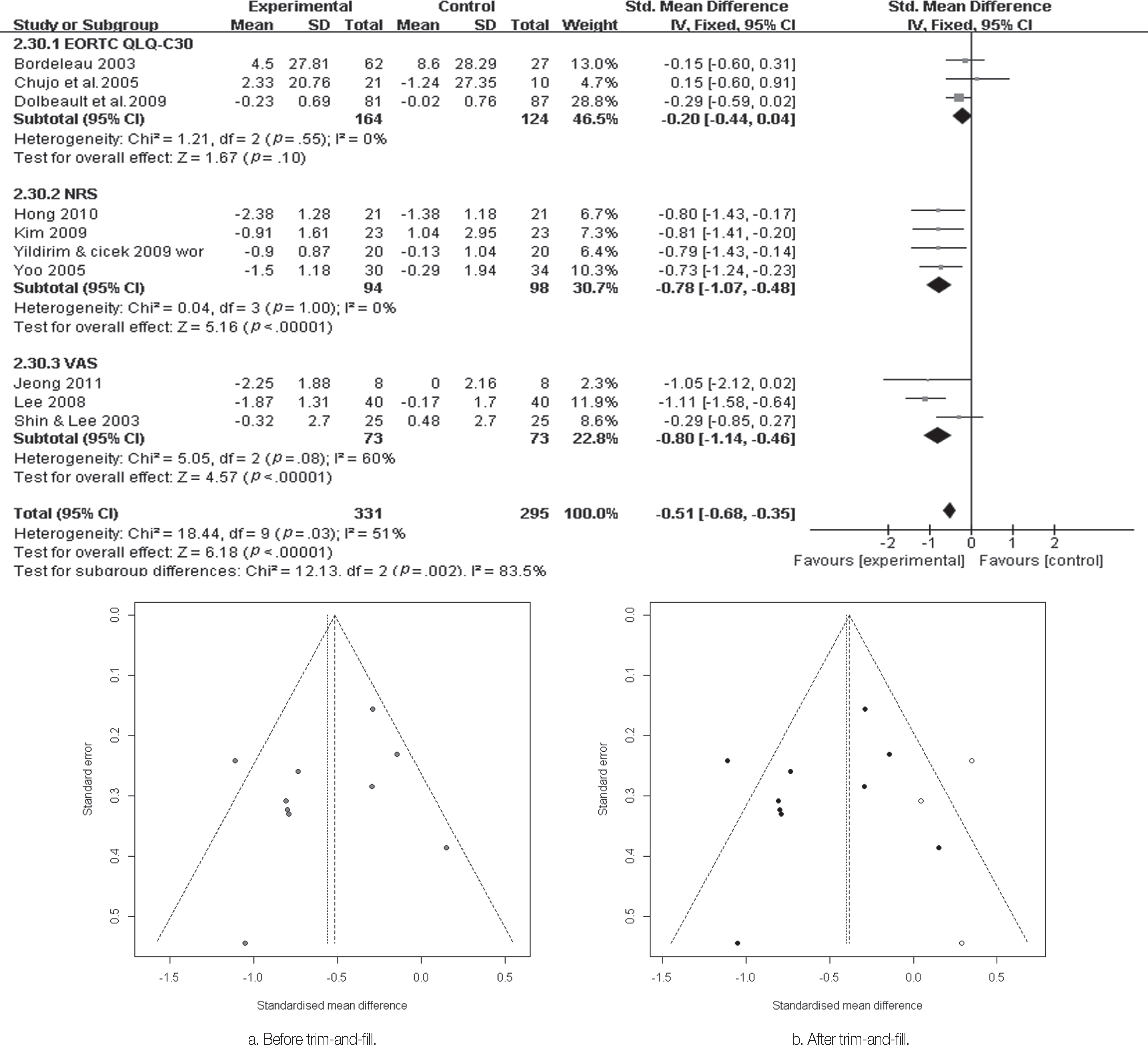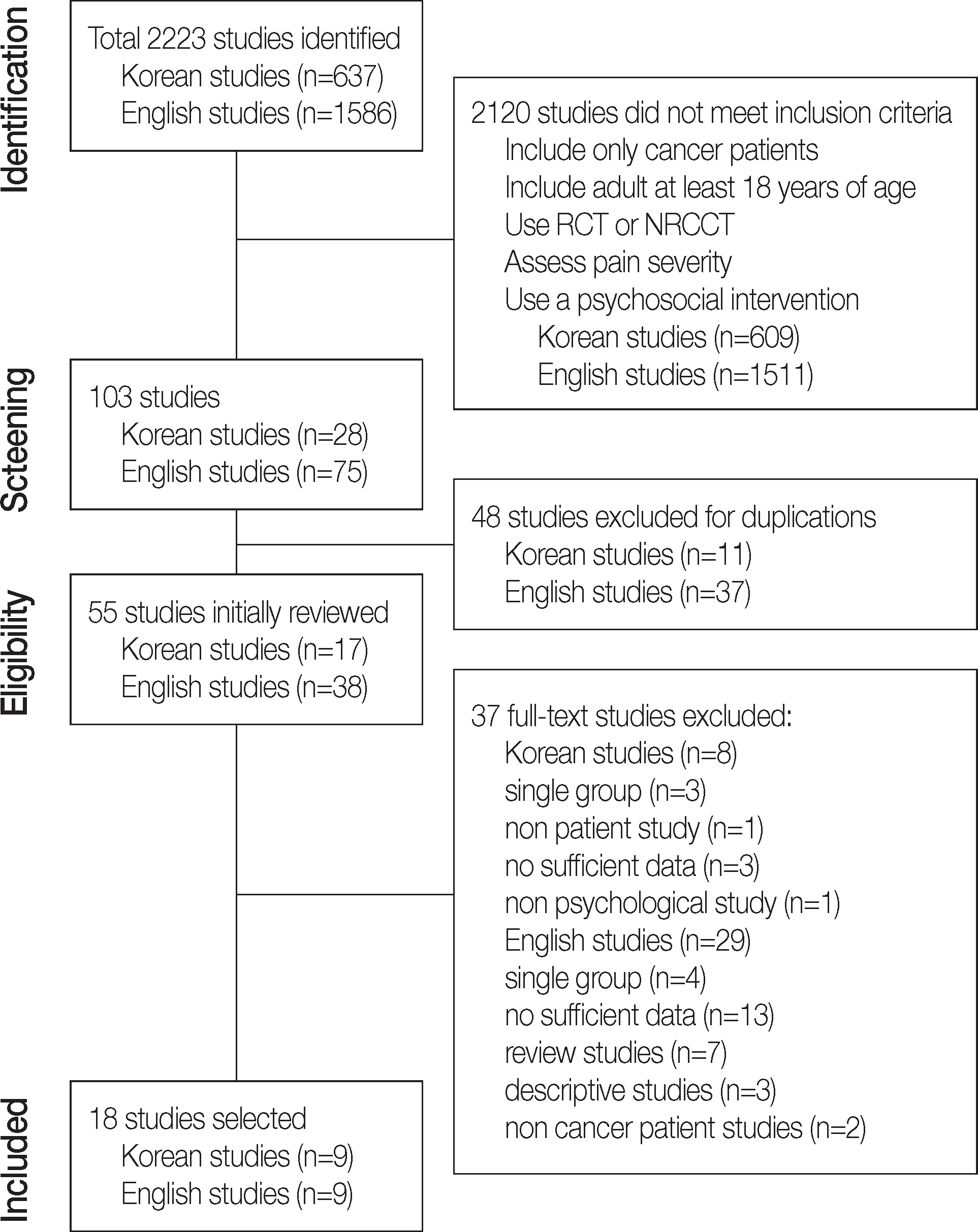Abstract
Purpose
Methods
Results
References
 | Figure 2.Forest plot of effect size and 95% CI by cognitive behavioral therapy on pain & funnel plot of effective sizes by standard error for pain. |
 | Figure 3.Forest plot of effect size and 95% CI by education interventions on pain & funnel plot of effective sizes by standard error for pain. |
 | Figure 4.Forest plot of effect size and 95% CI by psychosocial intervention on pain & funnel plot of effective sizes by standard error for pain. |
Table 1.
| References | Sources | Designs | Subjects (stage/analgesic) | Sample sizes | Interventions | Outcomes (Timing of measurement) | Scale | Direction of effect | ||
|---|---|---|---|---|---|---|---|---|---|---|
| Exp. (n) | Cont. (n) | Name/type | Weeks/Number of Sessions/Min | |||||||
| Bordeleau (2003)* | Journal (non-nursing) | RCT | Metastatic breast cancer (unclear/unclear) | 80 | 36 | Supportive-expressive therapy/ group | 48/48/90 | Pain severity (4,8,12 min) | Symptom subscales of EORTC QLQ-C30 | No diff. |
| Chujo et al. (2005)¶ | Journal (non-nursing) | ) NRCCT | Breast cancer patient (recurrence/unclear) | ) 19 | 9 | Psychosocial group intervention/ group | 6/6/90 | Pain severity (immediately, 3,6 min) | EORTC QLQ-C30/ Br23 | No diff. |
| Dolbeaul (2009)* § | Journal (non-nursing) | RCT) | Cancer patient (ealry/unclear) | 81 | 87 | Psycho-educational group/group | 8/8/120 | Pain severity (immediately) | EORTC QLQ-Br23 | − |
| Goung (2003)¶ # | Master's (nursing) | NRCCT | Stomach cancer (terminal/narcotics) | 32 | 32 | Pain control education/ individual | 1/1/30-40 | Worst/Least/mean/ present pain (1 wk) | BPI-K | −/No diff./ -/No diff. |
| Hong (2010)¶ # | Master's (nursing) | NRCCT | Colon cancer patient (unclear/PCA) | 21 | 21 | Recovery nursing intervention/ individual | 4/4/30-40 | Pain severity (immediately) | NRS | − |
| Jeong (2011)¶ # | Master's (psychology) | NRCCT | Cancer patient (unclear/no | 8 | 8 | MBSR/group | 8/8/90 | Pain severity (immediately) | PPI/VAS | −/- |
| analgesics) | ||||||||||
| Kim (2009)¶ ** | Master's (nursing) | NRCCT | Cancer patients (3,4/narcotics) | 23 | 23 | Pain management education/group | unclear/9/30 | Analgesic use/ pain severity(1 wk) | BPI-K/NRS | +/- |
| Kroenke et al. (2010)‡§ | Journal (non-nursing) | ) RCT ( | Cancer patient (unclear/analgesics) | ) 137 | 137 | Telecare management | 12/3/ unclear(phone) | Pain severity (1,3,6,12 min) | BPI | − |
| Kwon, Whang, & Kim (2002)¶ ** | Journal (nursing) | NRCCT | Home cancer patient (terminal/unclear) | 16 | 16 | Pain management education/ individual | 1/1/30 | Pain severity (2-3 wks) | Patients Outcome Questionnaire | − |
| Lai et al. (2004)§ | Journal (nursing) | RCT | Cancer patient (2-4/unclear) | 15 | 15 | Brief pain education/group | 1/5/10-15 | Pain severity (immediately) | BPI-T | − |
| Lee (2008)¶ ** | Master's (nursing) | NRCCT | Gastric Cancer Patient (unclear/PCA) | 40 | 40 | Structured PCA education/ individual | 1/1/20 | Analgesic use/ pain severity (1 wk) | VAS | − |
| Lengacher et al. (2010) | Journal (nursing) | RCT | Breast cancer patient (0-4/unclear) | 40 | 42 | MBSR/group | 6/6/120 | Pain severity (within 2 wks) | MDASI | − |
| Shin & Lee (2003)¶ # | Journal (nursing) | NRCCT | Cancer patient (unclear/no drug) | 25 | 25 | Cancer pain management education/ Individual | unclear/unclear/ 20-30 | Pain severity (2 wks) | VAS | No diff. |
| Thomas et al. (2012)* †‡ | Journal (nursing) | RCT | Cancer patient (unclear/unclear) | Coach: 64 Education: 75 | : 88 | Education or motivational-interviewing–based coaching/group | 6/4/30(coaching, education-video) | ,) Body pain (6 wks) | BPI | No diff. |
| van der Peet et al. (2009)§ | Journal (nursing) | RCT | Cancer patient(unclear/pain score of 4 or higher) | 39 n | 44 | Intensive nursing-based pain education program/ individual | / 3/3/60-90 | Pain severity (4, 8 wks) | Ferrell's pain questionnaire | −/No diff. |
| Yates et al. (2004)†§ | Journal (nursing) | RCT | Cancer patient (unclear/unclear) | 87 | 79 | Pain management intervention/ Individual | 1/2/30 | Pain severity (1, 8 wks) | BPI | − |
| Yildirim & Cicek (2009)§ | Journal (nursing) | RCT | Cancer patient (unclear/unclear) | 20 | 20 | Pain education program/ individual | 3&7days/ unclear/ 30-40 | Present pain/worst pain/least pain (2, 4, 8 wks) | MPQ/NRS | −/No diff./- |
| Yoo (2005)¶# | Doctoral (nursing) | NRCCT | Lung cancer patient (unclear/unclear) | 30 | 34 | Web based education program/ individual | 1/1/15 / | Pain severity (3 wks) | NRS | − |
Exp.=Experimental group; Cont.=Control group; diff.=difference; RCT=Randomized controlled trials; NRCCT=Non-randomized controlled clinical trial; EORTC QLQ-C30=European Organization for Research and Treatment of Cancer Quality of Life Questionnaire-Core 30; EORTC QLQ-BR23=European Organization for Research and Treatment of Cancer Quality of Life Questionnaire-Breast cancer module 23; VAS=Visual Analog Scale; NRS=Numeric Rating Scale; PPI=Present Pain Inventory; BPI-K=Korean Version of Brief Pain Inventory; PMI=Pain Management Index; BPI=Brief Pain Inventory; BPI-T=Brief Pain Inventory-Short Form Taiwanese version; MDASI=M.D. Anderson Symptom Inventory; MBSR=Mindfulness-Based Stress Reduction; SF-36=Short Form-36; MPQ=McGill Pain Questionnaire; BQ-r=Barrier Questionnaire-Revised; BQ-K=Barriers Questionnaire Korean version; *Allocation concealment;




 PDF
PDF ePub
ePub Citation
Citation Print
Print



 XML Download
XML Download